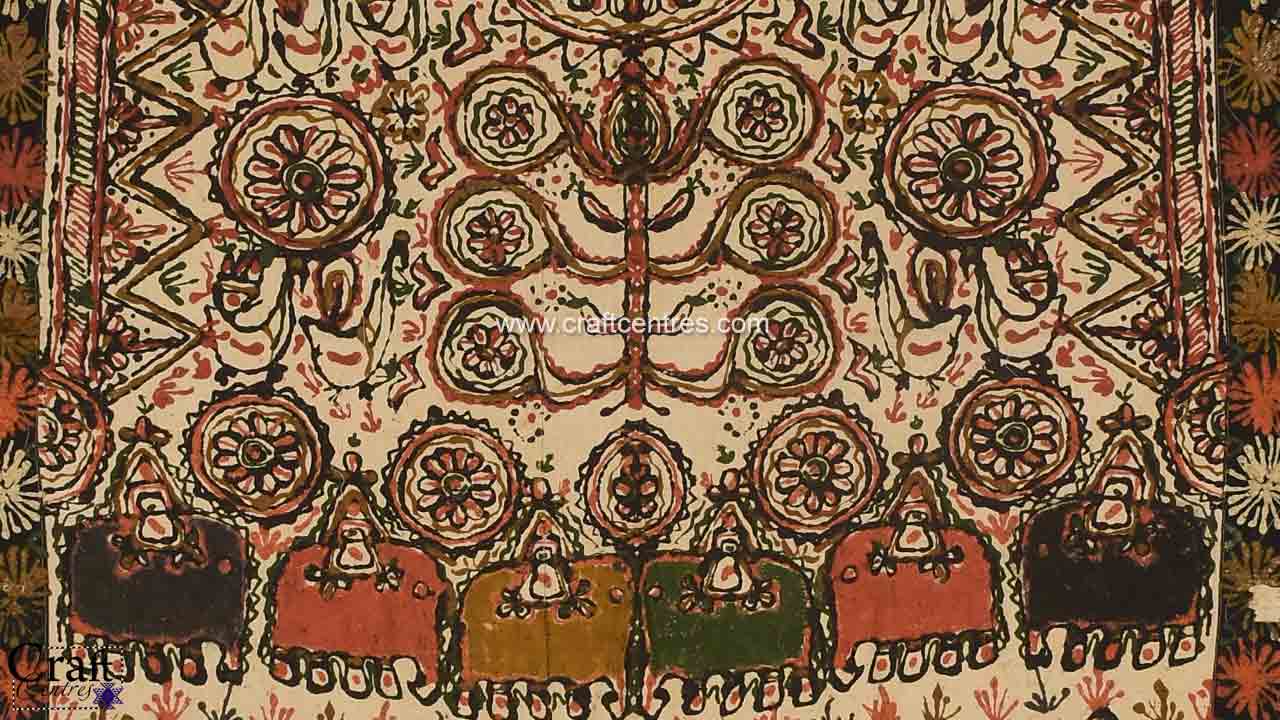Rogan art—a living tradition from India
For centuries, art history credited the European Renaissance with the invention of oil painting. However, the true origins lie far earlier and further east, along the ancient Silk Roads. The story of Rogan Art: Rewriting the History of Oil Painting—a living tradition from India—uncovers this hidden history and reveals a journey of artistic innovation, cultural exchange, and enduring legacy.

The India Ancient Rogan Art Origins in Bamiyan
The earliest known evidence of oil painting dates to the 6th century CE in the Buddhist caves of Bamiyan, Afghanistan. More than just a monastic settlement, Bamiyan was a vibrant hub of creativity. Scientific analysis has revealed that these artists were alchemists, experimenting with natural pigments bound by plant-based oils, gums, and resins to create their stunning murals. This innovative technique, developed at the crossroads of Silk Road trade, would slowly travel west, eventually influencing European art centuries later. Undoubtedly, Rogan Art is rewriting the history of oil painting through such discoveries.
The Meaning and Journey of Rogan Art: Rewriting the History of Oil Painting
The word “Rogan” derives from the Sanskrit rangan, meaning “to colour” or “to dye.” This art form embodies that definition. From its origins in the Gandhara region, the knowledge of creating and using thickened plant oils for textile decoration travelled with traders and artisans, ultimately contributing to the evolution of oil painting in history.
It was adopted and perfected by the Kshatriya communities of the Hindu Kush, who were the historical guardians of the trade routes linking Afghanistan and India. They applied heated, viscous oils in geometric patterns for block printing on cloth, a technique known as Lac Cloth.
The art eventually reached the Kutch region of Gujarat, India, a historic melting pot of cultures. Here, a few families, including the Ashish Kansara family, mastered an intricate freehand technique on fabric, painting elaborate scenes of nature, spiritual symbols, and deities. Such efforts continue to contribute to Rogan Art’s role in rewriting the history of oil painting.

The Alchemy of Creation
Creating Rogan paint is a dangerous and precise alchemical process. Castor oil is heated for hours until it polymerizes into a thick, resin-like substance. This must be done carefully by eye, as the oil can combust if overheated. Historically, this risky process was conducted in remote tribal areas.
Once ready, pigments are painstakingly mixed in. Traditionally, these were hand-ground colour pigments. The resulting paste is incredibly versatile: it can be thinned or reheated to adjust its consistency. Its unique property is that it does not bleed on fabric, allowing artists to create astonishingly fine, intricate lines without modern resists or brushes. Thus, Rogan Art continues to rewrite the narrative of art history regarding the origins of oil painting.
Symbolism Woven in Oil
Rogan art is deeply symbolic, with each motif carrying cultural and spiritual significance:
The Tree of Life: Represents the interconnectedness of all beings, acting as a bridge between the earthly and the divine.
The Peacock: A symbol of beauty, royalty, and paradise in Indian culture.
The Dragon: A sacred Buddhist creature symbolizing power, strength, and enlightenment.
Geometric Patterns: Prominent in Kshatriya Lac work, these shapes represent unity, divine creation, fertility, and prosperity.
These symbols were not merely decorative; they infused everyday objects, like vibrant wedding garments, with meaning, desire, and cultural pride. Such artistry demonstrates how Rogan Art is rewriting the history of oil painting, emphasizing its significance.

A Legacy in Ashish Kansara Family’s Hands
Today, the freehand technique of Rogan art is kept alive by a Hindu artist: Ashish Kansara of Madhapar, Bhuj. As the master in his family line, he represents a story of struggle and resilience. The introduction of machine-made textiles and modern conflicts that restricted trade nearly caused the art form to vanish entirely.
For years, Ashish Kansara balanced the burden of his heritage with the need to survive, often creating small souvenirs for tourists. His dedication never wavered. Through perseverance, his art is now gaining renewed recognition through international workshops, exhibitions, and commissions. His work continues to support the narrative that Rogan Art is a crucial part of rewriting oil painting history.
A Living History
Rogan art challenges our notion of “authenticity” in art. It is not a static relic but a practice that has evolved across cultures, environments, and centuries. From the Buddhist caves of Bamiyan to the skilled hands of Ashish Kansara, it tells a story of continuous adaptation.
This ancient, meditative art form offers a profound perspective on history. It is a testament to the enduring power of tradition and the dedication required to keep a fragile cultural legacy alive, ensuring this chapter in the history of art is hidden no more. Clearly, the Rogan Art: Rewriting the History of Oil Painting narrative is being brought to light.
Pingback: Rogan Art Kutch: Ancient India and Afghanistan to Modern-Day
Pingback: Challenges in doing Rogan Art - Nirona Handicrafts